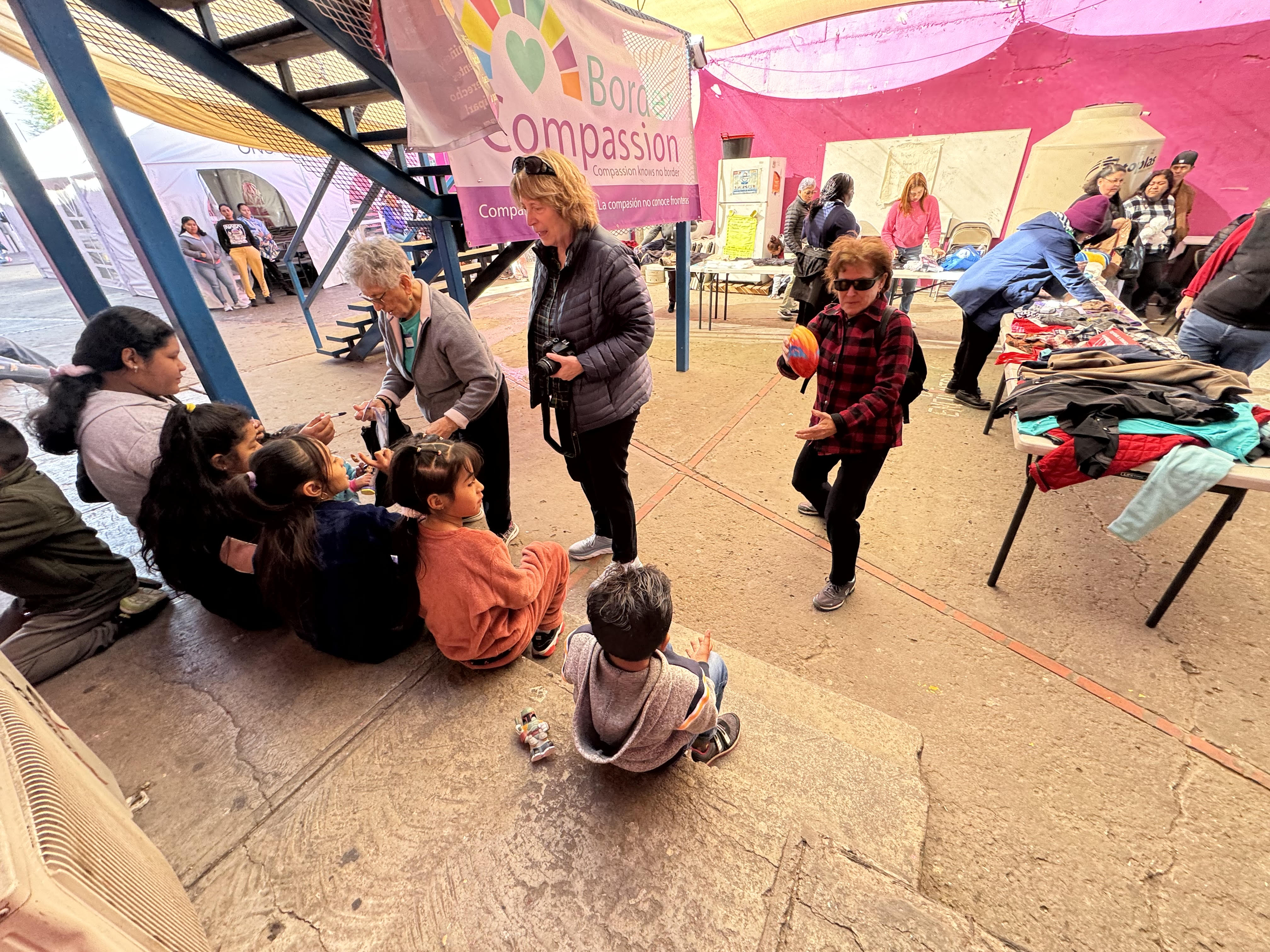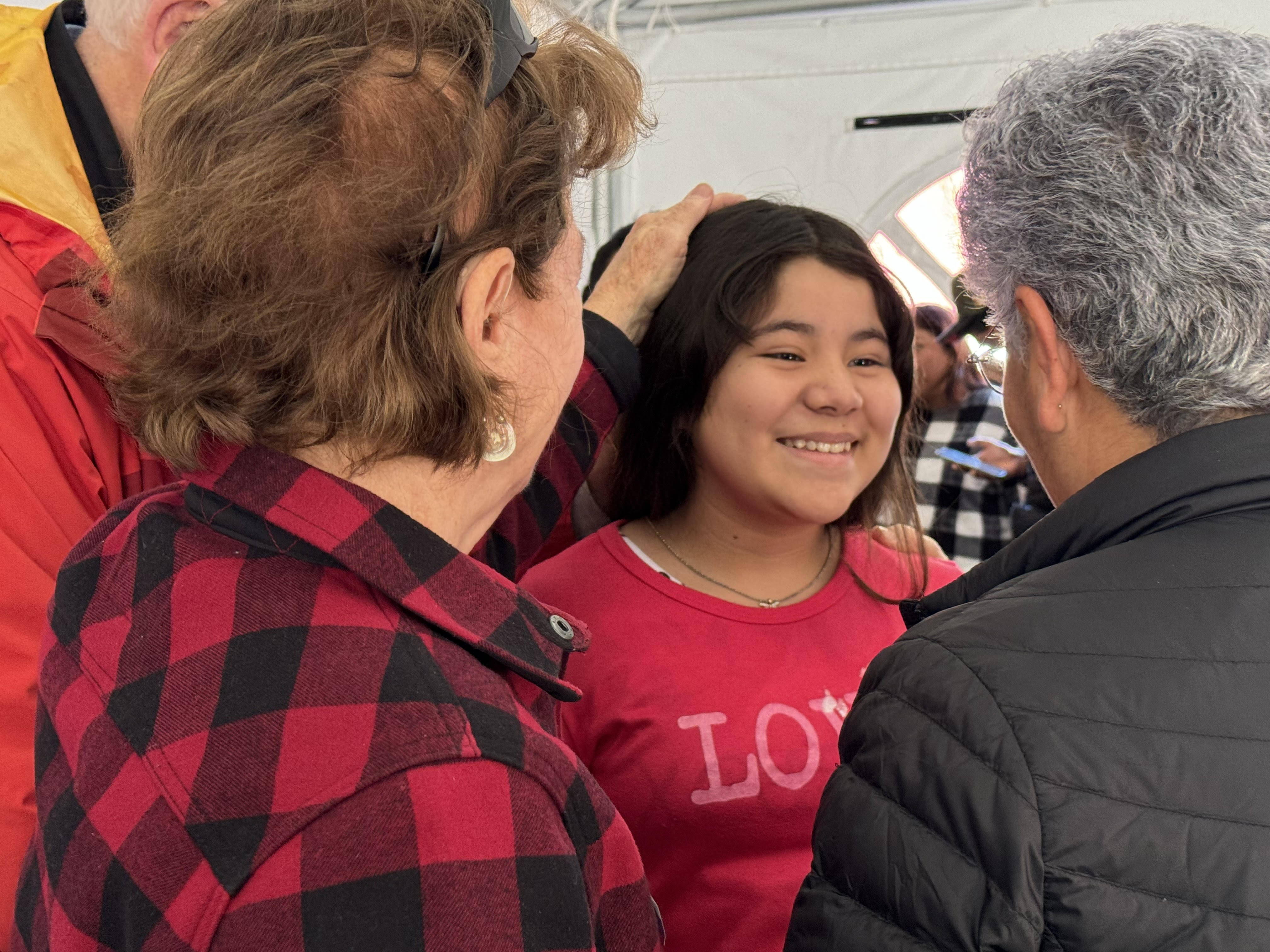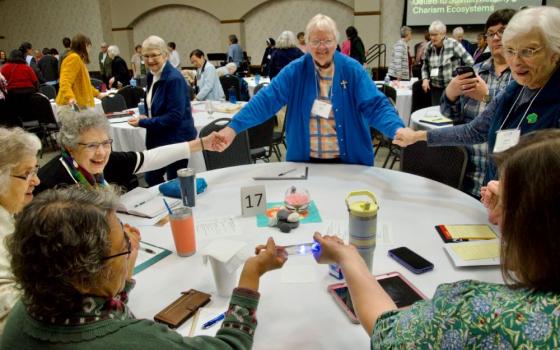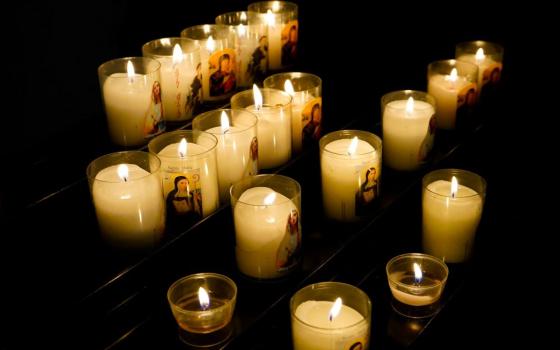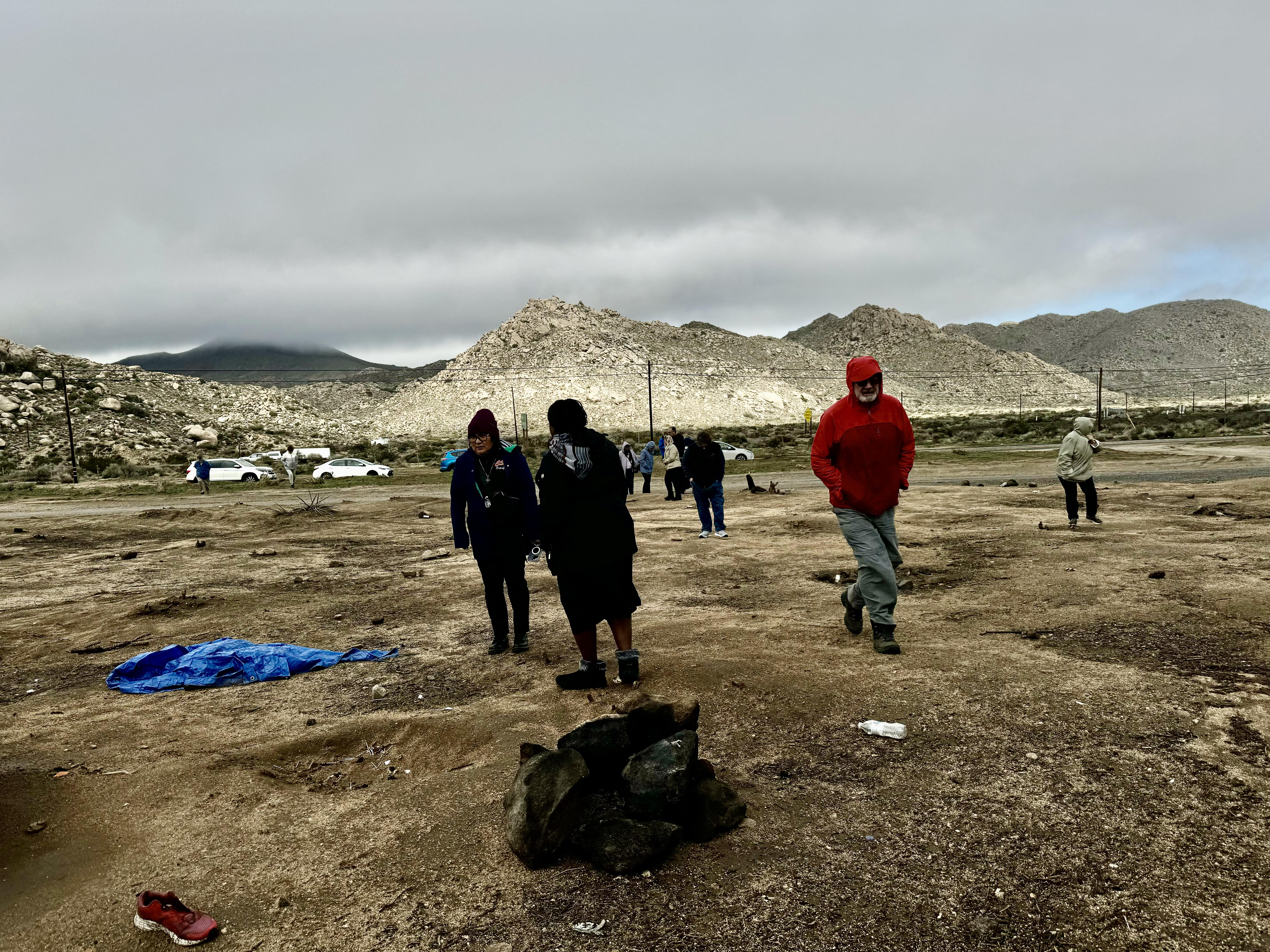
A group of women religious, along with a priest and a Franciscan friar, stop by an abandoned camp in the desert, near Jacumba Hot Springs, south of San Diego, Feb. 7. Some prayed near the shoes, tattered tents and wet sleeping bags left behind where migrants sought shelter from the cold rain and snowstorms affecting the San Diego region this winter. (GSR photo/Rhina Guidos)
Editor's note: Global Sisters Report's new series, "Welcoming the Stranger," takes a closer look at women religious working with immigrants and migrants. While we cover this topic often, this series will feature sisters and organizations networking to better serve those crossing borders, global migration trends and the topic of immigration in the upcoming U.S. presidential election.
Congress' latest attempt at immigration reform in early February was going down in flames. The sisters were keeping tabs on it. But their focus Feb. 5-9 was the road from San Diego via the cold desert toward Mexico, to see what the landscape, migrants and the Holy Spirit had to say to them during a five-day "border pilgrimage."
"This wasn't just nuns crossing the border and feeling good," said Sr. Suzanne Cooke, provincial of the U.S.-Canada Province of the Society of the Sacred Heart, one of about two dozen sisters from various congregations who participated.
It was an opportunity to contemplate "What is God saying? What's my responsibility?" she told Global Sisters Report Feb. 9 about the pilgrimage.
On the route along the U.S.-Mexico border, the sisters heard moving stories and found abandoned camps in the desert, as well as cemeteries with anonymous makeshift headstones.
What spoke to her and others were the stories from those they met on both sides of the U.S.-Mexico border, including a family of 10 from Afghanistan running from the Taliban's treatment of women; a Peruvian family of seven who left after threats from criminal elements; and a young Chechen escaping Russia.
Though silent, landmarks that sisters visited in the desert also told of the tragedies and ignominy people on the move are increasingly facing, such as "a potter's field with a fence," as one sister said of a dirt plot where unidentified remains — believed to be of migrants — are buried and kept behind a chainlink fence in a cemetery. Or a group of feeble tents, the only shelter that protected recent border crossers from the winter's cold rain and snow that have pummeled the desert south of San Diego this season.
"We were talking 'pilgrimage,' but it seems almost like the Stations of the Cross," St. Joseph of Carondelet Sr. Suzanne Jabro said of the tales of hardship along the way.
Jabro, along with Sacred Heart Sr. Lisa Buscher, Mercy Sr. Mary Waskowiak, and Franciscan Friar Keith Warner — all from California's San Diego and Palm Desert area — organized the pilgrimage. It began and ended with a reflection at the Franciscan School of Theology at the University of San Diego.
The organizers billed this on the theology school's website as an opportunity for congregations to think about "next steps in ministry to migrants, whether direct service, pastoral care, education or advocacy." But the pilgrimage also provided the opportunity to network and discern, as religious, what is happening at the border beyond the headlines and how to respond, Jabro said.
The organizers of the pilgrimage believe the journey will generate a reflection on ministry with migrants that will guide religious communities toward future direct actions of service.
The pilgrimage sought to go beyond a border immersion experience, Buscher said, and attempted to engage sisters in looking at the situation "with the eyes of the heart."
At times, it was an exercise that produced pain and tears.
Sr. Clara Malo Castrillón, provincial of Mexico's Society of the Sacred Heart, wept as she rested her head against a fence that separated the migrant remains buried at Terrace Park Cemetery in Holtville, California, during a Feb. 7 pilgrimage stop.
Unable to enter the area, which has a locked gate, she and other sisters threw flowers over the fence that landed near the bricks marked "John Doe" that serve as tombstones for the unknown. They prayed for those buried there, some who drowned or died of exposure. They also prayed for the families who may never know what happened to their loved ones.
Sr. Phyllis Sellner, of the Sisters of St. Francis of Rochester, Minnesota, said she couldn't help but think of the Holy Family as she looked at the cold landscape of another pilgrimage stop, an abandoned camp near Jacumba Hot Springs, an unincorporated community south of San Diego.
The spot, until recently, served as an unofficial outdoor detention site for migrants turning themselves in to border authorities. Volunteers had been taking water, food and other necessities to those at the desolate spot in the wilderness after crossing the nearby border to the U.S. side.
Some sisters in the group prayed, others looked inside the tents and at the objects left behind: wet sleeping bags, shoes, a small cooking pot with a large piece of wood that looked as if it had been used to stir food.
"It was very disheartening for me. I kept thinking about Mary and Joseph traveling over the rocks and the desert, probably meeting with people who didn't want them there. It came flooding over in my mind," Sellner said in a reflection at the end of the pilgrimage.
'This wasn't just nuns crossing the border and feeling good.'
—Sr. Suzanne Cooke of the Society of the Sacred Heart
But sisters also shared smiles, candy and helped crack open Valentine's-Day-themed piñatas with children and adults at the Cobina Posada del Migrante shelter in Mexicali, Mexico, Feb. 8. In return, the women at the shelter made pozole, a popular Mexican soup of hominy, to share with the sisters.
Still, the enormity of the humanitarian plight was never far behind. A Honduran woman, whose husband, a diabetic, was facing renal failure, entered the shelter with a wound on the man's leg during the celebration.
Malo reflected the following day that it was hard to see the difficulties those they came into contact with found themselves in, including many fleeing "a violence that no one can stop," such as corruption and other ailments.
"Life could be good for most of these people" if governments made an effort to solve problems, she said, and it was sad that "the only answer they [migrants] can think of is 'Let's go to the United States,' " because they see no solutions at home.

Sisters contemplate a stained-glass window depicting the Holy Family at a chapel inside the Instituto Madre Assunta shelter in Tijuana, Mexico, Feb. 6. The shelter, run by Scalabrinian sisters, was one of several stops for women and men religious on a five-day border pilgrimage Feb. 5-9 in and around San Diego as well as the U.S.-Mexico border. (GSR photo/Rhina Guidos)
Sr. Anne Carrabino, a member of the Sisters of Social Service, said she thought of how U.S. Cold War policy and its past interference in Latin America had much to do with creating "push factors" that have led people to leave their native countries. And yet leaving homelands in turbulence isn't always the cure-all, given the difficulties and sometimes hostility that people on the move encounter even if they're successful entering a more stable country — legally or otherwise.
"I was thinking, they have no idea what awaits them," she said.
For Sr. Mary Grace Ramos, the week's visits and stops presented a "rewind" of her life, as she remembered how her mother had left the family home in the Philippines to find work in Hong Kong and later Canada. It was the only way to provide her and her siblings with an education, said the Sister of St. Joseph of Orange, California.
"It's not just here that it's happening," Ramos said, struggling to contain tears. "It happens in Asia. ... All of this struggle ... it's happening all around the world."
Sr. Catherine Murray, of the Dominican Sisters of San Rafael, California, said that, in the good and difficult things they encountered, "pilgrimage is a holy journey."
Advertisement
"The attitude with which I come is, this is not a tour," said Murray, chairperson for Region 14 of the Leadership Conference of Women Religious. Like Carrabino, she said it was important to share the pilgrimage experience with other communities and discern what steps to take going forward.
In the middle of the border journey, on Feb. 7, Republicans in the Senate rejected a rare bipartisan bill on immigration, which the sisters had been paying attention to. Regardless of what happens — or doesn't — in Congress, the sisters seemed to be buoyed by their experience.
"We need to tell the story, we need services, we need everything," Carrabino said. "We've got ideas and energy."
Waskowiak told GSR that the happenings at the border are increasingly becoming of interest to communities of women religious.
"I know a lot of women religious feel this is a new calling," she told GSR. "Before, it was teaching. Now, it's the border. This is the time."
This story was originally published in Spanish, Feb. 26, 2024.

